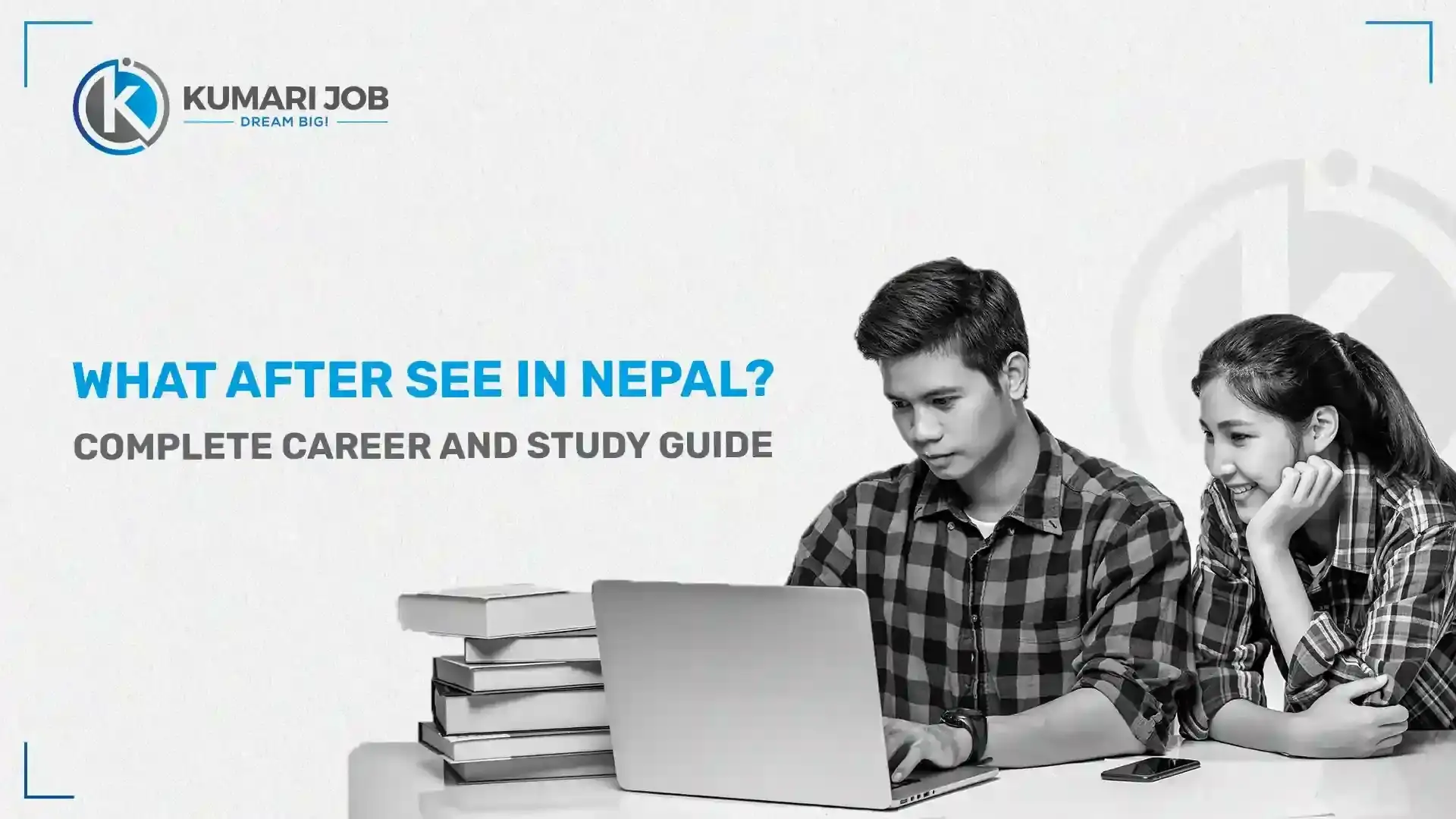
Just got your SEE results? First of all, congratulations! This is a big moment, and it’s totally normal to feel a mix of excitement and confusion about what to do next. You’re now at an important crossroads, where you’ll choose the path that shapes your future. Now comes the big decision: what next? Friends may talk about +2 Science, CTEVT diplomas, or short skill courses. Each path costs time and money, but choosing early can get you scholarships and your first preference seat.
In this simple guide, we will walk you through each of the important choices after SEE, let you know what each option offers you, and help you figure out what suits you best. Let's make your next move simple and strong.
In this blog
What To Do After SEE in Nepal?
By the time you finish SEE, you will be delighted, but maybe a little confused about where to go from there. That is perfectly okay! The first thing is to think about what you like and what you are good at. Do you like science, mathematics, or invention? Or do you like fixing things, drawing, or helping people? Knowing about your interests will help you make the right decision.
Three major alternatives to SEE are academic studies like +2, technical/vocational training, and short skill courses. The academic route is studying subjects like science, management, or humanities for two years. Technical training is learning the important aspects of a job, like electrician tasks or computer hardware. Skill programs are short and get you to learn a certain set of skills, like coding or cooking.
It's always a good idea to talk with people who know you. Your parents, teachers, or siblings can advise you based on your strengths and goals. They can also guide you on the application process and assist you in determining what alternatives are best for you. Don't hesitate to ask questions or express concerns.
Finally, remember that your choice now is important but not final. Many people change paths later, so don’t feel pressured to decide everything right away. Take your time, gather information, and pick a path that feels right for you. This way, you’ll be happier and more confident in your future steps.
What to Study After SEE in Nepal?
You've completed your SEE exams. Now it's up to you to decide what to study next. This choice is important as it affects your future career and life. Luckily, Nepal offers different alternatives after SEE, so you can pick the best one for you. If you want to study further academically, gain practical knowledge, or prepare for competitive exams, there's something for you. Let's consider these choices one after the other, and you can make an informed choice.
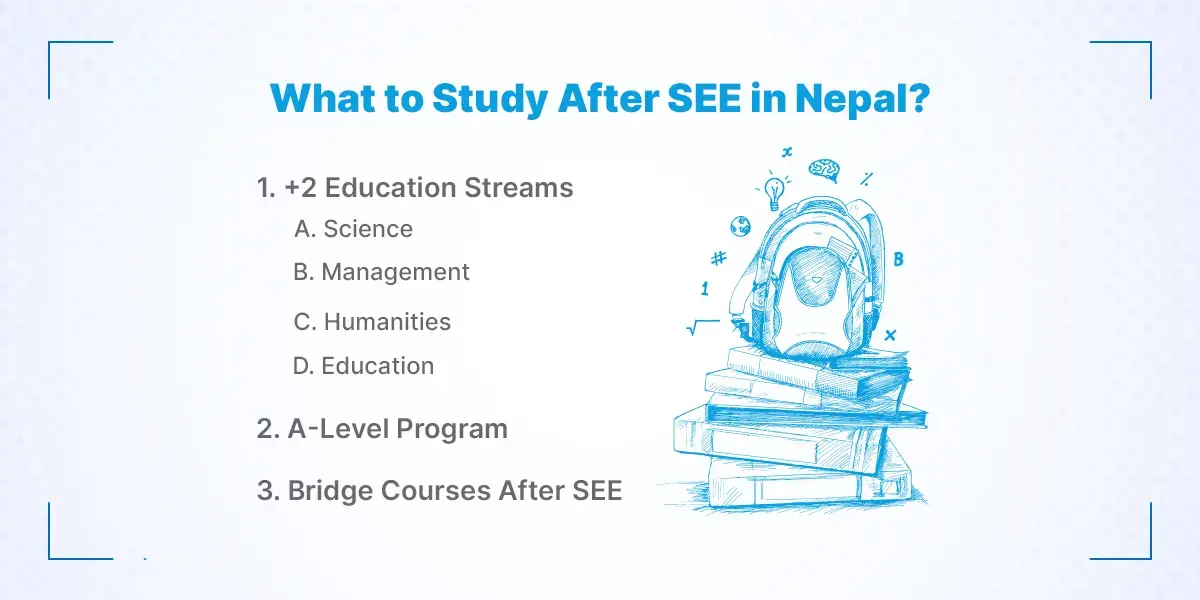
1. +2 Education Streams
The +2 level is the most popular choice among students after SEE. It is like the next two years of schooling, where you prepare for college or university. You have many streams or groups of subjects to pursue, according to your interests and what you want to do in life.
Here are the most important +2 streams that you can opt for:
A. Science
If you like studying subjects such as math, physics, chemistry, and biology, then the Science stream is for you. It is perfect if you want to be an engineer, doctor, nurse, IT professional, or scientist in the future. It is tough as there are a lot of practical classes and exams, but it has numerous good job and study opportunities.
B. Management
If you enjoy business, maths, and organisation, management could be your path. You study subjects like accounting, economics, business studies, and maths in this stream. Careers in banking, business management, marketing, and finance come out of this stream. It's normally a less demanding stream than Science, but equally beneficial for the majority of careers.
C. Humanities
Humanities is also a good choice if you like reading, writing, history, or social studies. You learn about culture, languages, society, and human behavior. This stream allows you to become a teacher, journalist, social worker, or government office worker. Humanities may be your best choice if you like talking about ideas and people.
D. Education
This is a modest but important stream committed to becoming a teacher. If you want to become a teacher in schools or help children learn, the education stream teaches you about teaching and child psychology. After completing postgraduate education, you can choose to pursue a B.Ed. and begin your career as a teacher.
How does +2 work?
+2 is a two-year course under the National Examination Board (NEB) of Nepal. You have to choose your stream and college. The courses are mostly theoretical but also contain some practical work and projects. After two years, you write the +2 board exams. If you work well, you can get into university or get a job related to your stream.
+2 is cost-effective because most private and government colleges offer it. Scholarships are available for good SEE scores. It's a good choice if you want a transparent, well-known path to higher studies or professional courses.
2. A-Level Program
The A-Level is another option besides SEE but different from +2. It's an international course that private colleges and schools in Nepal organize. The A-Level pursues the UK's Cambridge curriculum.
What makes A-Level different?
- It is two years long, like +2, but uses a different method of instruction.
- The focus is more on understanding and applying knowledge, not just memorizing.
- You can choose your own combination of subjects. For example, you can study Physics, Economics, and Accountancy together, which is not possible in +2.
- Most A-Level courses are in English.
Who should study A-Level?
If you want to study overseas in the future, A-level is an appropriate choice since most foreign universities accept it. Further, if you want a flexible timetable for study and fewer students in each class, this course can be appropriate for you. But remember that A-Level is more expensive than +2 and requires strong English skills.
3. Bridge Courses After SEE
Some students wish to concentrate on entrance exam preparation for difficult entrances immediately after SEE. These entrances are for the best science, medical, and engineering colleges in Nepal. To assist in this regard, most institutes offer bridge courses or crash courses.
What are Bridge Courses?
Bridge courses are short, usually a few weeks to a couple of months. They are meant to reinforce students' knowledge in subject areas like mathematics, physics, chemistry, and biology. The objective is to prepare students for competitive exams like the IOE engineering or medical entrance exams.
These courses give tips on exams, important concepts, and past question papers to obtain high scores. Many students take these courses with the expectation of getting scholarships or admission into top colleges.
Who Should Take Bridge Courses?
If you are a hardworking student who is ready to study science and medicine and is ready to work hard for entrance exams, bridge courses are a great option. They are not a substitute for +2 but a bonus. You may take them along with your +2 or after SEE before you take +2.
Which One Should You Choose?
Selecting what to pursue after SEE is subject to your interests, future career, and budget.
- If you want a typical route and intend to study in Nepal's universities in the future, +2 would be the safest option.
- If you wish to study abroad or prefer having flexibility in the curriculum, A-level would be a better option for you.
- If you want to study well for competitive exams and get scholarships, choose a bridge course along with +2 or even after SEE.
Consult with your parents, teachers, and counselors before making a decision. Think about what you enjoy and what you want to become as a profession in the future. There is no need to hurry. Take your time and choose what suits you.
Technical and Vocational Education Options After SEE
If you want to switch from classroom learning to real work as soon as possible, Council for Technical Education and Vocational Training (CTEVT)-affiliated Diploma and Technical School Leaving Certificate (TSLC) programs are a smart option. They focus on "learning by doing," so you spend more time in the lab, workshop, or field than in classrooms. All TSLC courses are 18 months long, and Diplomas are three years long, both admitting students straight away after SEE, with no requirement for +2.
What Fields are Available?
1. Agriculture
Learn modern agriculture, animal farming, and crop management. Graduates may work on private commercial farms, start their own agricultural businesses, or serve on government schemes related to food security.
2. Engineering
Choose any of the civil, electrical, mechanical, or computer subfields. During the course, you acquire fundamental design, machinery maintenance, and safety procedures that factories and construction companies are looking for.
3. Health
Health Assistant, Lab Technician, or Community Medicine courses provide you with patient care, basic diagnostics, and first aid. Placements for these students are readily available from hospitals, clinics, and NGOs.
4. Hospitality
Study hotel operations, cookery, and tourism services. Nepal's booming tourism industry demands trained staff in hotels, restaurants, and travel agencies, so jobs come fast.
Why attend TSLC or a Diploma?
- Early employability: Since the courses are vocational, you can start earning sooner, possibly even within two years of completing the SEE.
- Lower cost: The tuition fees are generally less than +2 plus bachelor's, and the government or scholarships partly fund many seats.
- Easy career advancement: With a Diploma, you can earn and then promote to a bachelor's or specialized certificate without sacrificing income.
- Practical education: Smaller class sizes and hands-on labs mean more one-on-one training and real tools in your hands, building confidence.
Who is it for?
These programs are ideal for individuals who prefer hands-on work over lengthy theoretical classes, want to support their families earlier, or aspire to run their own workshop, clinic, or farm. If that is you, visit a nearby CTEVT school, ask about application dates, and tour the labs before you apply.
In short, TSLC and Diploma courses offer a fast, affordable bridge from SEE to skilled employment. If you’re eager to work with tools, help patients, cook amazing dishes, or build real structures, this path could be your perfect next step.
Best Training Courses After SEE in Nepal
Many students prefer short-term skill training right after SEE instead of joining +2 or A-Levels. Such trainings are specialized in one specific job skill and typically last from weeks to months. You get hands-on practice, meet people already working in the field, and have a small project or certificate to add to your CV to boot. Some institutes help you in finding internships, freelancing assignments, or even direct jobs soon after the course. If you're seeking immediate results and hands-on experience, these options are certainly worth exploring.
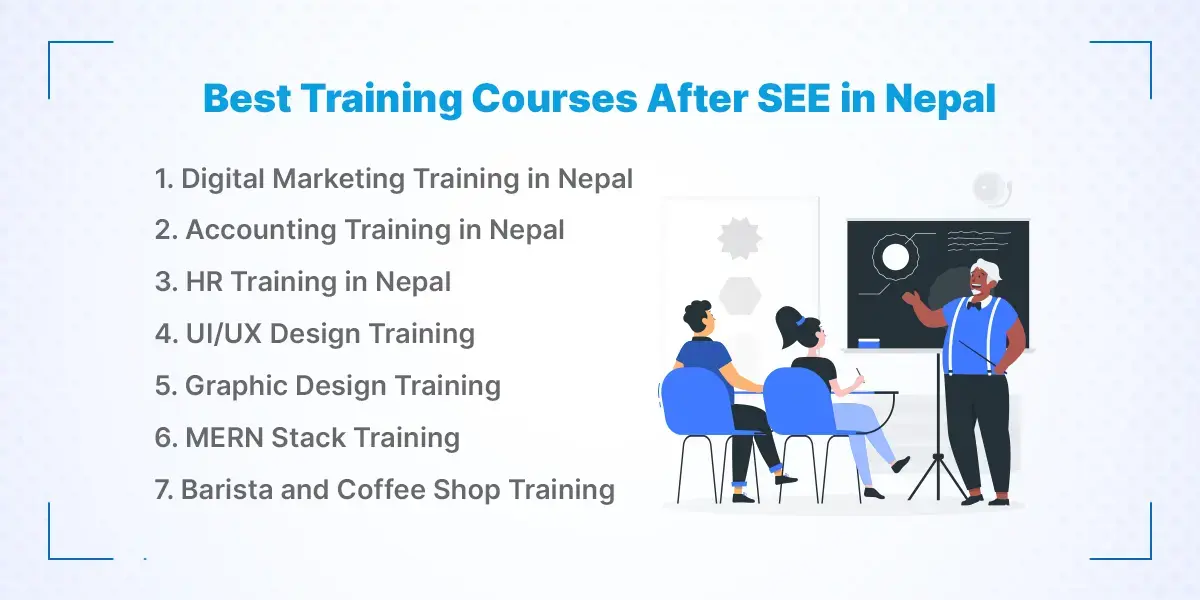
1. Digital Marketing Training in Nepal
Digital marketing courses teach you how brands talk to people on the internet. You learn the basics of SEO (getting websites to rank on search engines like Google), then move on to social media posts, promoted ads, and simple content strategies. Trainers take you through tools like Facebook Business Suite, Google Ads, and Canva so that you may have the tools in your bag to work on small campaigns yourself. In most classes, you'll make an example ad set or blog posts that can be directly put into a portfolio.
Why choose it? Almost every Nepalese business needs someone to manage Facebook pages, TikTok videos, or websites these days. After finishing the course, you can apply for an assistant digital marketer job, freelance at local small stores, or even start your own social media account for pocket money. Because results are so easy to track, excellent performances can result in quick promotions and project incentives. And also, if you study management later on, this skill gives you an edge in marketing subjects.
2. Accounting Training in Nepal
Accounting courses are closely tied to day-to-day business operations. You get trained in Tally and Excel for book-keeping, make out invoices, and gain experience in basic tax calculations in line with Nepali rules. Trainers walk you through live bills and vouchers so you can balance books confidently. By the end of the accounting training, you should be able to make out a profit-and-loss account and file basic VAT returns.
This stream is suitable for students who love numbers and sequences. Every business today needs someone who can keep proper records, so initial jobs are the same. Experienced ones become an accountant, finance officer, or you can even start your own small audit firm. Plus, the skills easily carry forward into further studies in Management, BBA, or CA if you wish to do so later.
3. HR Training in Nepal
HR short courses introduce you to office life from the human perspective. You'll be made familiar with composing job advertisements, CV filtering, and booking interview times. Trainers also show you standard HR software, leave monitoring, and basic labour law. HR training educates you on polite email writing, welcome addresses, and conflict de-escalation.
These skills are applicable to any beginner office career, not just HR. Small businesses prefer to hire freshly graduated HR assistants to handle paperwork, phones, and new-hire orientation. Experience enables you to move on to recruitment agencies or the corporate HR department. In case you pursue Management or Psychology later, this early experience is great for your resume applications.
4. UI/UX Design Training
UI/UX design is about creating user-friendly and visually appealing designs for websites and mobile apps. Many UI/UX training programs in Nepal begin with basic sketching techniques and progress to wireframing tools like Figma. You’ll also learn color theory, font pairings, layout design, and how to conduct simple user testing with peers.
By the end of most courses, you'll have built a mini-app or website prototype — a strong addition to your portfolio for job interviews. This field blends creativity and technology, making it perfect for those who enjoy both design and problem-solving.
UI/UX training in Nepal can open doors to entry-level positions in startups and IT companies. There’s also good freelance demand on platforms like Upwork for clean, minimalist app interfaces. As you grow, you might specialize in product design, front-end development, or brand strategy.
5. Graphic Design Training
Graphic design trainings help you learn tools like Photoshop and Illustrator. You'll be cropping photographs, color correction, and adding text on banners in the initial weeks. Later lessons involve logo creation, brochure creation, and social media templates. You have actual client briefs from teachers that you have to work on under deadlines.
All Nepali printing presses, advertising companies, and publishing houses need designers. You may start working as junior designers, create posters for neighborhood festivals, or sell custom designs on the internet. Graphic design training in Nepal offers these practical skills in a structured way. Design skills being visual, your portfolio serves a greater purpose than certificates. Many graphic designers freelance to earn extra income, so this course is not only useful but also flexible.
6. MERN Stack Training
The MERN stack training: MongoDB, Express, React, Node.js, helps you learn full-stack web development. You begin with basic JavaScript, then build simple servers in Node and data storage in MongoDB. Then React, where you build modern, lightning-fast user interfaces. At the end of the course, you'll have a working web app, like a small blog or e-commerce example.
Why learn MERN? Nepali and international IT companies hire junior developers every month, and MERN is one of the most popular stacks. Remote work is common, so you can work with international clients while staying at home. If you keep practicing and acquire skills like TypeScript or Docker, your salary can grow quickly. For technically oriented students who enjoy problems, this course offers a gateway to international opportunities.
7. Barista and Coffee Shop Training
This training teaches you about the different types of coffees like espresso, cappuccino, latte, americano, cortado, etc., along with customer service and overall café operations. You will also learn how to handle coffee machines, take orders, maintain hygiene, and interact with customers in a professional setting. A few courses also offer soft skills like reading the menu and billing.
It's a great option if you enjoy working in hospitality and want a quick entry into the workforce. Coffee culture in Nepal is growing quickly, especially in cities like Kathmandu and Pokhara, and cafes always need trained baristas. You can work in cafes, restaurants, or even dream of owning your own small coffee stall one day after training. It's a short course but can lead to long-term jobs and career growth in the food and beverage industry.
Select a course that suits your interests, pricing, and schedule. All these trainings are short, practical, and job-focused, which is perfect if you want to start earning or freelancing soon after SEE. Whichever you begin, keep learning, build a minimal portfolio, and be curious; the skills you acquire today can propel your career for the next three decades.
What If I Didn’t Score Well in SEE?
Didn't receive the grades you hoped for? Getting bad grades won't put an end to your future. Nepal offers plenty of opportunities where grades don't matter as much as work ethic and passion. Take a look at some clear ones you can start right now.
1. Research TSLC, Skill-based Training, or Bridge Courses
TSLC and CTEVT diploma programs enroll SEE graduates regardless of their grade. You learn by doing. Fixing machinery, caring for patients, or cooking in real kitchens. Most of the programs take 18 months to three years, so you can earn sooner than the traditional +2 route. With limited seats, an early application is more valuable than a high GPA.
Bridge courses have an added benefit if you still want to study Science or Engineering later. They cover vital concepts quickly, help with mock tests, and focus on test-taking strategies. Even students with average grades can secure merit seats later with a bridge course. Many institutes offer scholarships based on performance in the entrance and not on SEE marks. Therefore, focus on the next test, not the last one.
2. Focus on Skill Development Instead of GPA
Employers are generally more interested in what you can do, rather than how you did in school. Short coding training, digital marketing training, accounting program training, or training in design software can be done in a few weeks. These credentials demonstrate real skill and help cover up the gap left by poor grades. Online learning sites like Coursera and training centers in Nepal both work if you can provide a final project.
Build a mini portfolio, which may be a website you've built, a logo set, or some test spreadsheets in Excel. Share it on LinkedIn or share it with nearby companies. Real evidence can help you grow from a low-grade student to one who produces results. Add new skills continuously, and your value grows more rapidly than any report card mark.
3. Freelancing
Freelancing involves offering services such as graphic design, writing, video editing, and others to clients online. You can start with simple skills, create a profile on websites like Fiverr or Upwork, and work on small projects to gain reviews. Each finished project is a valuable learning experience in life and a valuable addition to your portfolio. The income may be slow at first, but it soon picks up once you specialize.
The bright side? Customers aren't likely to request your SEE grade; they evaluate your work instead. Even a couple of solid projects can take priority over an average transcript. Use free YouTube tutorials to enhance during in-between jobs. Freelancing can ultimately fund additional schooling or be your career.
4. Entrepreneurship
Another option is to begin a micro-business. Think small and open in your own house if possible: a home bakery, phone repair, selling clothes on the Internet. Begin with market research, ask your friends what they need to know about the market trends, look at prices, and discover gaps. Make a fair budget, begin selling, and learn from every customer interaction.
Profits may be low at first, but the experience is priceless. You’ll practise finance, marketing, and customer service daily, which are the skills that employers admire. Government programs and NGOs sometimes offer free training for young entrepreneurs, focusing on ideas rather than grades. With a strong determination, your skills can grow into a stable income.
Tips to Prepare for Life After SEE
Life after SEE is exciting, but it may become stressful if you are not aware of where to start. The good news is that you do not need to have it all lined up at once. Small, wise steps will guarantee your success. Below are some simple tips to prepare you for the journey ahead.
1. Build Digital and Communication Skills Early
Start with basic computer work on a daily basis. Master faster typing, creating PowerPoint slides, and working on spreadsheets in order to complete basic tasks. These small practices smooth out school assignments and impress the potential employer. Evident digital skills give confidence to learn new tools quickly.
Communication is just as important. Join a debate club, exchange English conversation with friends, or blog about your hobbies. Good writing and speaking allow you to convey ideas, ask questions, and solve problems in any career. The sooner you master these skills, the smoother your ride will be.
2. Explore Volunteering, Internships, or Freelancing
Volunteering for an NGO, school event, or community clean-up helps you learn responsibility and cooperation. You will have role models, learn about the way organisations operate, and know what kind of career you enjoy. Even a few hours a week can give you real-life experience to add to your CV.
Short internships or minor freelance work, like designing posters or guiding juniors, enable you to make some pocket money while building a portfolio. Small businesses in your area and websites typically have space for eager starters. Each project shows employers that you can meet deadlines and deliver real work. It's a low-stakes arena in which you can try out possible professions before you invest.
3. Avoid Pressure & Make Well-Informed Choices
Your friends may likely go into +2 Science or some prestigious college because everybody else is doing it. But take a moment to think about what you enjoy doing and where you'd like to be in five years' time. Hurried choices can lead to boredom or expensive course changes later. Trust your own schedule.
Visit colleges, talk with seniors, and compare costs and career prospects. List the pros and cons of each path so that you can see them clearly. Show your list to parents, teachers, or advisers who know your strengths. An unstressed, well-informed decision helps in stress reduction and enables long-term success.
4. Use Online Resources and Short Courses to Get Started
The internet is full of learning tools that are free. Platforms like YouTube offer introduction courses in anything from coding to baking. Start off with short videos and quizzes to see if a subject interests you. This way, you can try everything before spending money on longer courses.
There are also a few weeks to month-long courses offered by local training centers in skills like accounting, graphic design, coding, and more. These shorter courses add solid, work-ready skills to your resume. Completing a course gives you a confidence boost and shows potential teachers or employers that you can learn quickly. Keep learning until you find the skill set that best fits you.
Conclusion
After SEE, your path is open to many possibilities, from academic studies to vocational training and skill courses. The key is taking a course that aligns with your goals and desires, and not taking things blindly based on what others have done. Keep in mind that success is not only because of grades but also because of your effort and education.
Start developing skills, take advice, and stay open to new opportunities. Whichever career path you take, if you are patient and work hard towards your career, you can build a brilliant and rewarding career. Your journey is just beginning. Believe in yourself and proceed confidently.
Are you ready to start your career? Check out the fresher jobs in Nepal to find the latest entry-level job vacancies and kickstart your professional life today.


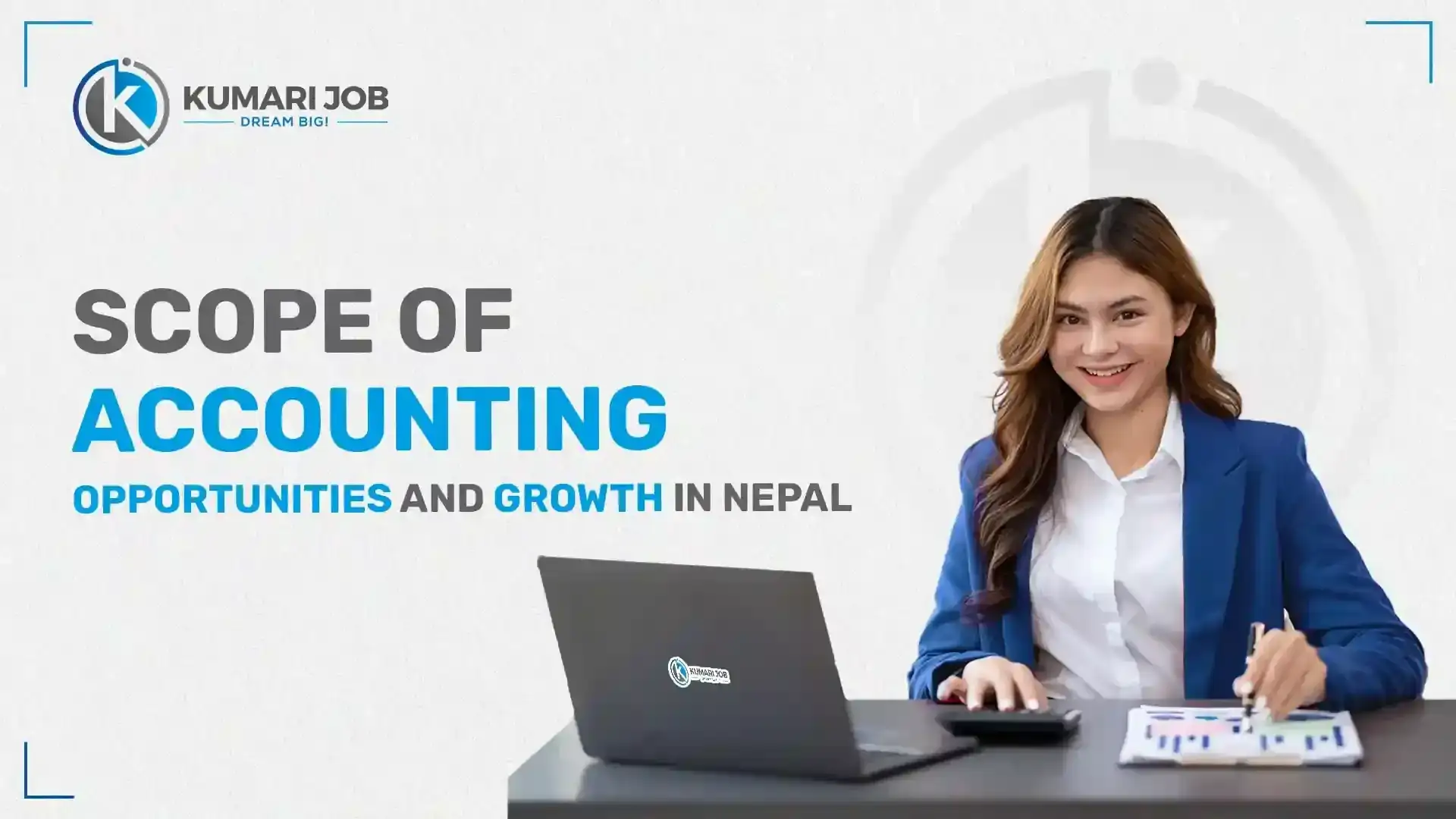
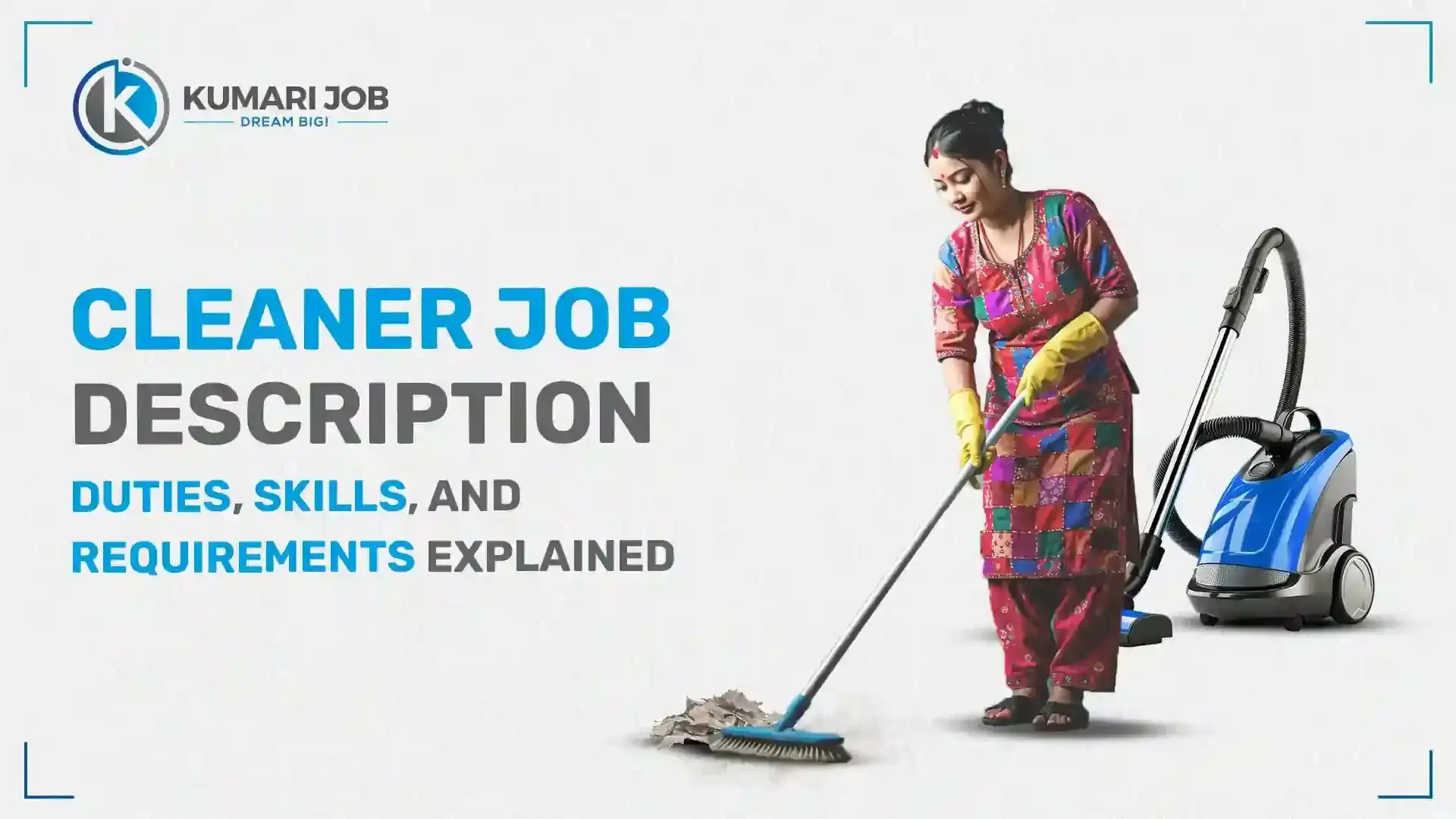

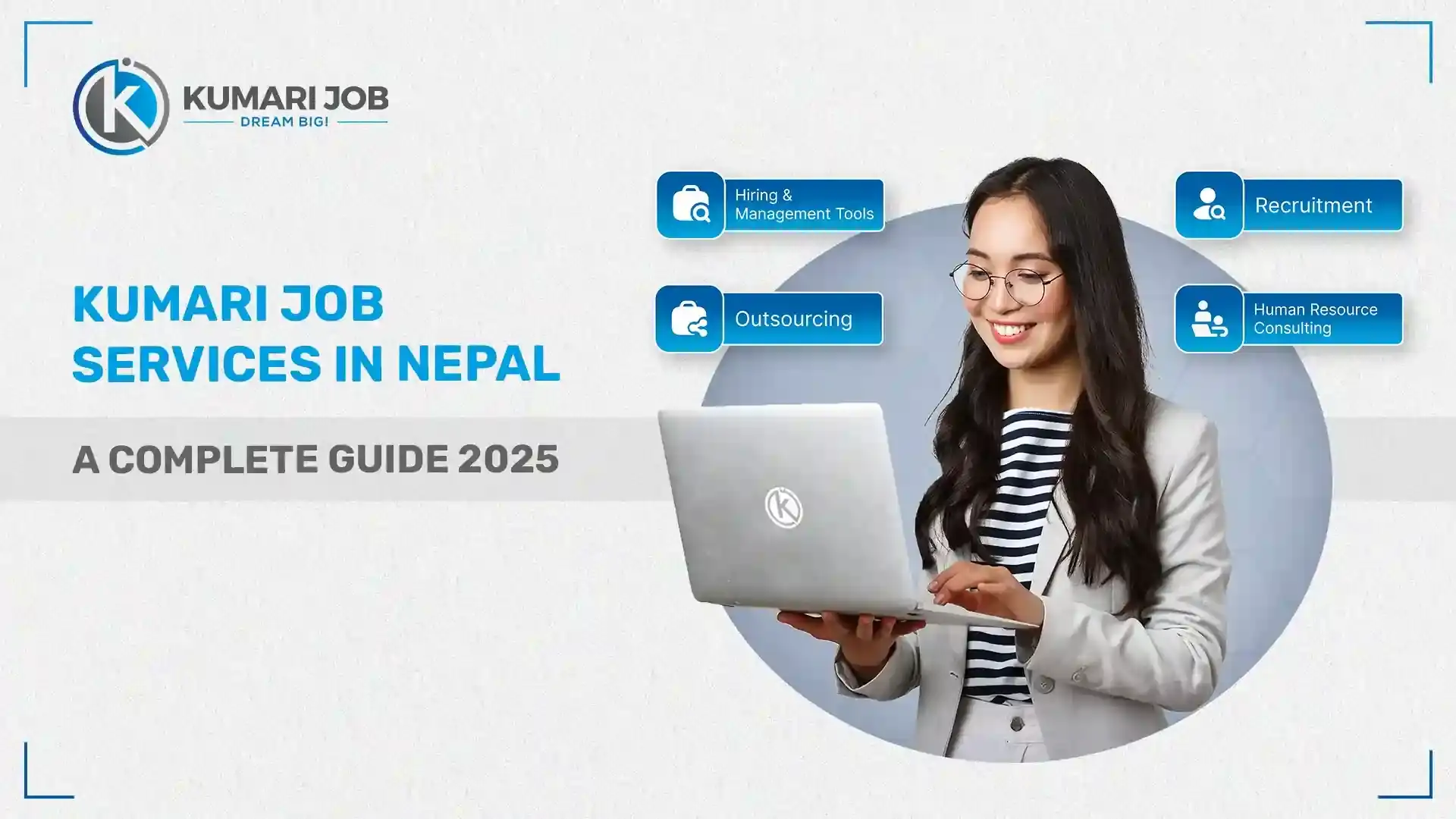
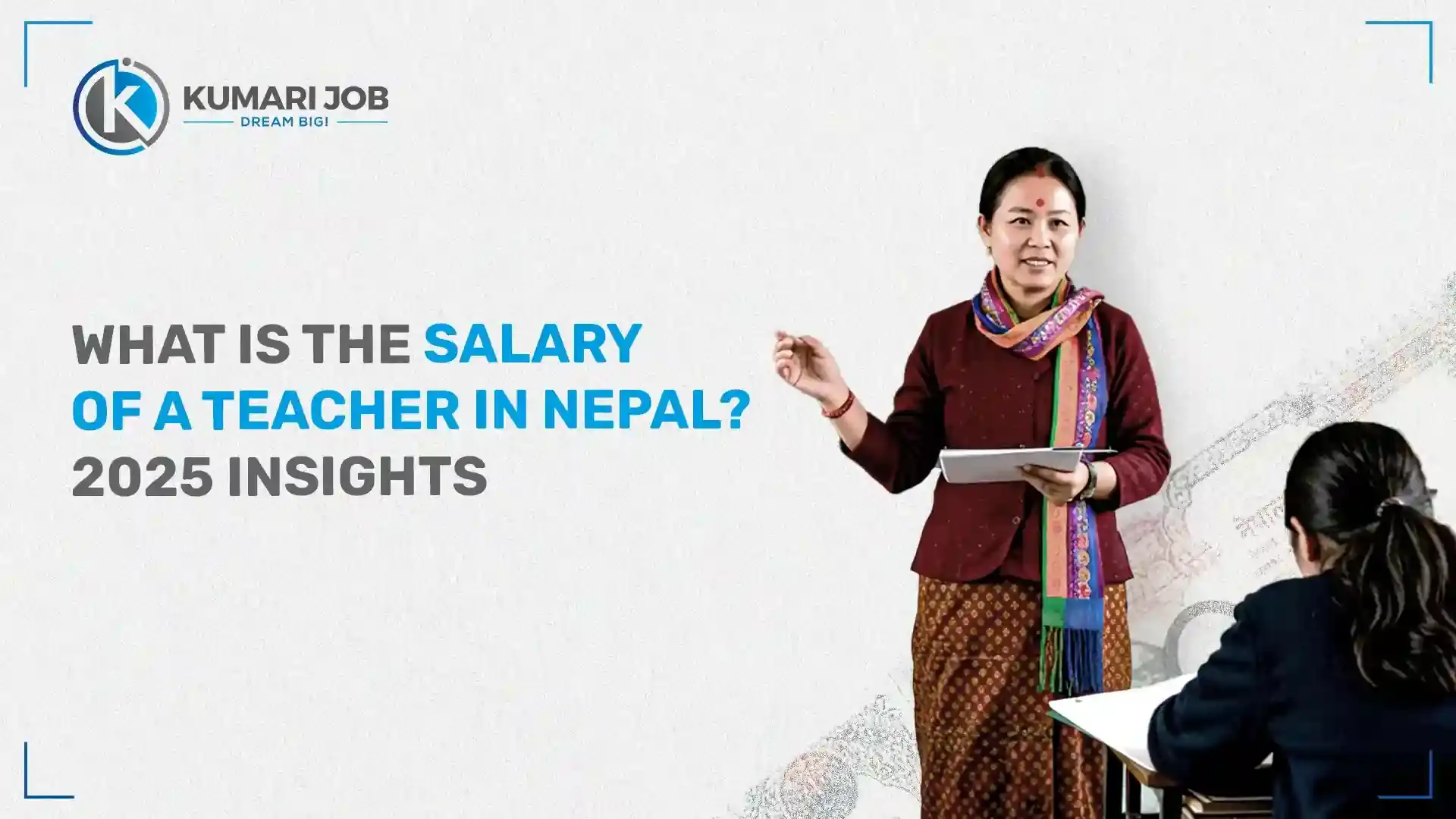
Loading Comments...